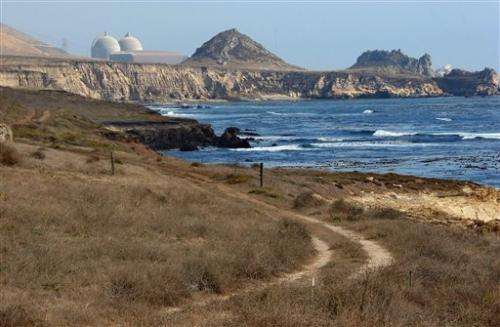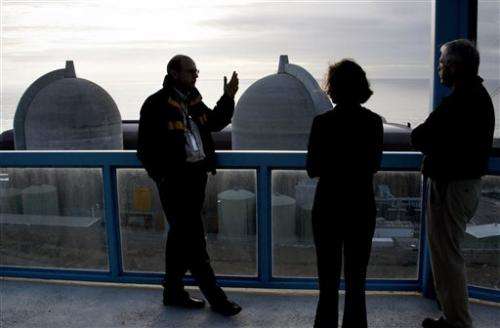Expert calls for nuke plant closure (Update)

A senior federal nuclear expert is urging regulators to shut down California's last operating nuclear plant until they can determine whether the facility's twin reactors can withstand powerful shaking from nearby earthquake faults.
Michael Peck, who for five years was Diablo Canyon's lead inspector, says in a confidential report that the Nuclear Regulatory Commission is not applying safety rules it set out for the plant's operation.
The document, which was obtained and verified by The Associated Press, does not say the plant is unsafe. Instead, according to Peck's analysis, no one knows whether the facility's equipment can withstand strong shaking from those faults—the potential for which was realized decades after the facility was built.
Continuing to run the reactors, Peck writes, "challenges the presumption of nuclear safety."
Earthquake faults and nuclear power plants have long been uneasy neighbors in the state. The Humboldt Bay plant in Northern California, which was relatively near three faults, was shut down in 1976 to refuel and reinforce its ability to withstand earthquakes.
Peck's 2013 filing is part of an agency review in which employees can appeal a supervisor's or agency ruling. The NRC, however, has not yet ruled. Spokeswoman Lara Uselding said in emails that the agency would have no comment.
The NRC, which oversees the nation's commercial nuclear power industry, and Diablo Canyon owner Pacific Gas and Electric Co., say the nearly three-decade-old reactors are safe and that the facility complies with its operating license, including earthquake safety standards.
PG&E spokesman Blair Jones said the NRC has exhaustively analyzed earthquake threats for Diablo Canyon and demonstrated that it "is seismically safe." Jones said in an email that the core issue involving earthquake ground motions was resolved in the 1970s with seismic retrofitting of the plant.

Following the AP report, the Senate Environment and Public Works Committee announced it would hold hearings into how the NRC has handled Peck's recommendation. Sen. Barbara Boxer, a California Democrat who chairs the panel, said in a statement she's alarmed his report has lingered at the agency for a year. "The NRC's failure to act constitutes an abdication of its responsibility to protect public health and safety," she said.
The disaster preparedness of the world's nuclear plants came into sharp focus in 2011, when a coastal plant in Japan suffered multiple meltdowns because of a magnitude-9 earthquake and tsunami. The NRC has since directed U.S. nuclear plants to reevaluate seismic risks, with studies due by March 2015.
The importance of such an analysis was underscored Sunday when a magnitude 6-earthquake struck Northern California and injured scores of people.
Environmentalists have long depicted Diablo Canyon—the state's last nuclear plant—as a nuclear catastrophe in waiting.
What's striking about Peck's analysis is that it comes from within the NRC. At issue are whether the plant's mechanical guts could survive a big jolt, and what yardsticks should be used to measure the ability of the equipment to withstand strong vibrations.
The conflict between Peck and his superiors stems from the 2008 discovery of the Shoreline fault. A larger crack, the Hosgri fault, had been discovered in the 1970s. Surveys have mapped a network of other faults north and south of the reactors.
According to Peck's filing, PG&E research in 2011 determined that any of three nearby faults—the Shoreline, Los Osos and San Luis Bay—is capable of producing significantly more ground motion during an earthquake than was accounted for in the design of important plant equipment.

The findings say PG&E failed to demonstrate that the equipment would remain operable if exposed to stronger shaking, violating its operating license.
The agency should shut the facility down until it is proven that piping and other systems can meet higher stress levels, or approve exemptions that would allow the plant to continue to operate, according to Peck's analysis.
Peck disagreed with his supervisors' decision to let the plant operate without assessing the findings. Unable to resolve his concerns, Peck in 2012 filed two objections, the first calling for PG&E to be cited for violating safety standards, according to his filing.
The NRC says the Hosgri fault line presents the greatest earthquake risk and that Diablo Canyon's reactors can withstand the largest projected quake on it. In his analysis, Peck wrote that after officials learned of the Hosgri fault's potential shaking power, the NRC never changed requirements for the structural strength of many systems in the plant.

In 2012, the agency endorsed preliminary findings that found shaking from the Shoreline fault would not pose any risks for the reactors. Those greater ground motions were "at or below those for which the plant was evaluated previously," referring to the Hosgri fault, it concluded.
Peck, an instructor at the NRC's Technical Training Center, declined to comment.
© 2014 The Associated Press. All rights reserved.



















